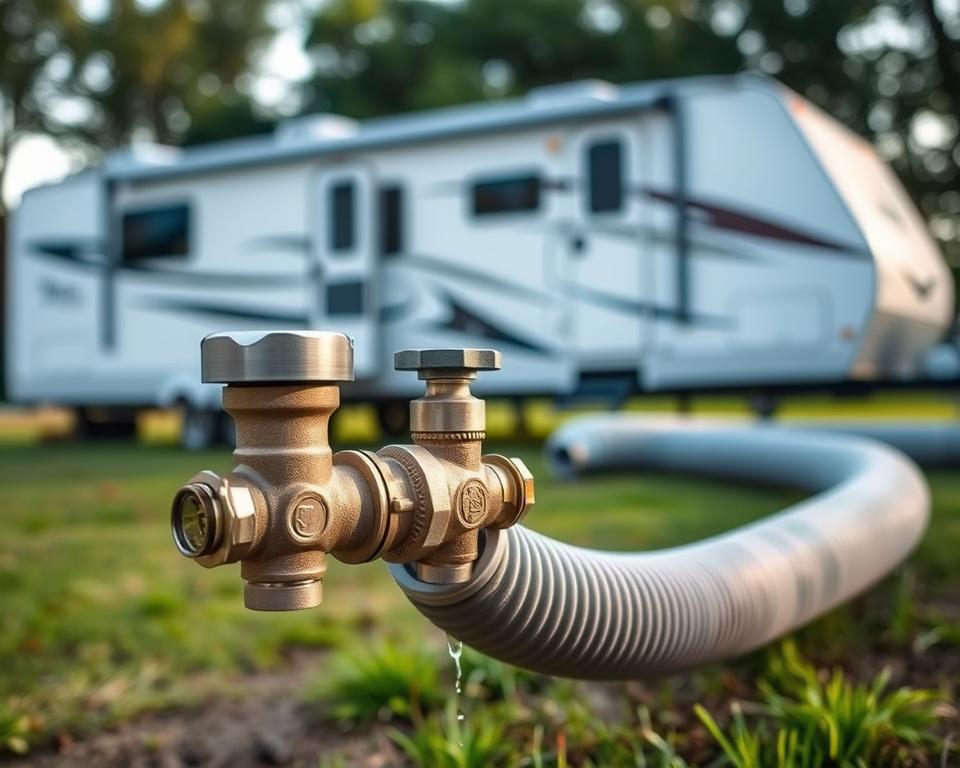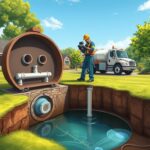Motorhome Water Tank & Pump: Essential Guide
Want to know what keeps your road trips running without a hitch? It’s chiefly due to your RV water Tank & Pump. Be it heading to the national-park circuit or a quick weekend retreat, commanding your RV’s water system is vital. In this guide we explore the basics: the components, upkeep, and best practices for smooth travel. Grasping each component, from the plumbing network to Tank filling, ensures water is always available during your outings – RV pumping near me.
Essential Highlights
- Knowing the RV water system optimises your travel fun.
- The RV water Tank and Pump are central for a steady water supply.
- Routine maintenance protects the longevity of your RV plumbing.
- Knowing how to fill your reservoir correctly can prevent future issues.
- Troubleshooting your water Pump can save you from unexpected problems.
Breaking Down RV Water Systems
RV water systems consist of two main parts: the potable-water setup and the wastewater mechanism. The fresh side boasts several core components like the storage Tank, Pump, and faucets, resembling home plumbing while catering to the mobile needs of life on wheels.
Using drinkable water is crucial for the system’s efficiency. It protects the well-being of all passengers. It’s vital to keep the RV plumbing in top shape through scheduled maintenance – covering proper drainage to prevent leaks and other faults. Timely inspections help RV enthusiasts avoid water-related mishaps during their journeys.

Why You Need the RV Water Tank
The RV water Tank is pivotal for a smooth journey. It holds the fresh water needed for drinking, cooking, and cleaning. The capacity of this Tank differs with each RV model, affecting how much water can be stored – and directly dictates how long you can travel before needing a refill.
Ensuring the RV storage Tank sanitary is essential. Periodic cleaning prevents harmful contaminants, ensuring water stays safe for use. Ignoring maintenance can encourage bacteria or algae growth, rendering the water hazardous.
Recognising the RV water Tank’s role streamlines water management during trips. Diligent upkeep and regular refills ensure a worry-free experience. It’s crucial to have ample water for all travel needs, guaranteeing a smooth RV adventure.
Filling Your RV Water Tank
Refilling your RV water Tank requires attentive action to confirm it’s done correctly. There are two primary methods: gravity filling and city-pressure filling. Understanding these techniques noticeably enhances your RV experience.
Gravity filling is simple. You just need a drink-safe water hose. Attach this hose to a water source, then to the Tank’s opening, and let gravity take over. Remember to watch the water level to prevent spills.
Pressure filling relies on a city water connection, offering faster results. You need to use a pressure regulator to manage water flow. Connect the hose from the municipal source to your RV. This method provides quick and steady supply to your Tank.
Choosing method you use, adhere to these important safety tips: Consistently monitor the fill when filling to prevent overflow, and draw only clean water to ward off health issues. Mastering these filling and safety techniques will make your RV trips even more enjoyable.
RV Water System: Parts in Focus
The RV Tank-and-Pump combo are crucial to any RV’s plumbing system, delivering a reliable and dependable water supply for all your needs. The RV water Pump’s main job is to move water from the reservoir, ensuring clean water is always on call. That’s vital for cooking, cleaning, and showering.
RV plumbing features different Pump types, each with distinct benefits. Diaphragm-style Pumps are favoured for their consistent water pressure, while centrifugal pumps are loved for mechanical simplicity and energy thrift. It’s important to weigh flow rate, noise, and installation ease when picking your Pump.
To wrap up, the RV water Tank and Pump are indispensable to your water system’s functioning. A robust Pump delivers strong pressure and smooth flow, boosting your overall travel experience.
Picking the Perfect RV Pump
Choosing the ideal RV water Pump is vital for your plumbing’s optimal performance. When evaluating a Pump, weighing several points is crucial for a satisfying camping experience. Ensuring it pairs with your RV’s water system is key.
Keep these primary aspects in mind:
- Flow Rate: Select a Pump with a flow rate that matches your usage needs. A stronger flow means faster reservoir refills.
- Pressure Ratings: Your RV’s different fixtures dictate the required pressure levels. Go with a Pump whose specs satisfy those figures for smooth operation.
- Noise Levels: Noise can be an issue with some Pumps. For a calm cabin, check models for their noise output.
Brands like SHURflo and VEVOR are high on the list for many RVers, and they offer stand-out perks. A careful assessment of these brands will help your purchase process.
Understanding these factors is not only crucial for the right purchase but also equips DIY tinkerers with key know-how for upkeep and replacements.
Connecting to City Water for Your RV
Hooking your RV to city water provides an continuous supply of fresh water, letting you bypass just using your Tank. This guarantees a more enjoyable camping experience. Be sure to follow proper steps for a secure hookup.
First, locate the city water connection port on your RV. It’s commonly marked by a bright or black connector, sometimes tagged for ease. Use a potable water hose rated for RVs; this kind of hose maintains your water safe from contaminants.
It’s critical to attach a pressure regulator before making the connection. This device shields your plumbing by taming the water pressure. With the regulator in place, connect the hose from it to the water source.
Once connected, keep an eye on the water pressure. Maintain a steady, gentle flow to avoid hose damage. Inspect your hoses regularly for any wear or leaks and quickly replace parts as needed.
Following these steps for city hookup enhances your camping convenience and assists in maintaining your RV’s condition.
Maintaining Your RV Water Tank
Making sure your RV’s water Tank is well cared for is essential for safe, clean water while out on adventures. A well-maintained Tank wards off bacterial growth and contamination. For starters, regularly sanitise the Tank: combine water with a bit of bleach for an effective residue-free clean.
It’s crucial to watch for leaks and manage Tank pressure. Routine checks can spot problems early, sparing expensive fixes. A maintenance routine preserves the water system in excellent health.
To streamline maintenance, use a checklist:
- Check water levels and quality often.
- Sanitise the Tank bi-annually with a bleach solution.
- Inspect for cracks in the reservoir.
- Monitor Tank pressure and Pump function.
- Flush the Tank to eliminate any sediment buildup.
RV Water Pump Troubleshooting
RV water Pump issues can be vexing, disrupting travel plans unexpectedly. Encountering strange noises, dealing with low pressure, or facing complete Pump failure are common problems. Understanding how to troubleshoot these issues can significantly enhance your trips.
If you hear odd sounds from your Pump is usually a problem. Start : check for loose connections and secure them. When confronted with low water pressure, checking hoses and fittings for leaks. Because a tiny leak can dramatically affect flow, prompt troubleshooting is essential.
If your Pump quits altogether, test electrical connections. Start with examining the Pump’s fuse. Should the fuse is fine, look further for wear or damage.
A step-by-step routine isolates and rectifies water system issues. Regular maintenance and inspection secure hassle-free journeys.
| Issue | Possible Cause | Suggested Solution |
|---|---|---|
| Strange Noises | Loose connections | Tighten fittings |
| Low Pressure | Leaky hoses/fittings | Find & seal leaks |
| Pump Failure | Electrical fault | Check fuse/wiring |
| No Water Flow | Blocked lines | Flush obstructions |
Tips for Effective RV Water Use
Travelling in off-grid areas typically entails limited water access. Wise use in your RV is crucial. By adopting smart conservation tactics, you not only manage resources well but also heighten camping satisfaction.
For maximum efficiency of water while travelling, try these tips:
- Take shorter showers – aim for under five minutes.
- Install water-saving fixtures like low-flow showerheads and faucets.
- Reuse grey water: dishwater can flush toilets or water plants.
- Monitor Tank levels regularly to prevent overflow.
- Plan water stops in advance: know filling stations along your route.
Conclusion
Understanding the nuts and bolts of your RV water systems is central to a fulfilling travel adventure. The Tank and Pump remain at the core of this, needing routine upkeep. By looking after these systems, you guarantee a dependable supply and dodge potential snags.
Consistent troubleshooting and checks reduce stress and save time. Being proactive about upkeep is essential, particularly when you’re miles away from help. Proper care allows you to optimise water use, raising comfort for everyone.
As you set off, keep this guide to master your RV’s water systems. Making informed choices about plumbing and equipment equip you to relish the freedom of the road. Wishing you joyous and smooth travels ahead!


